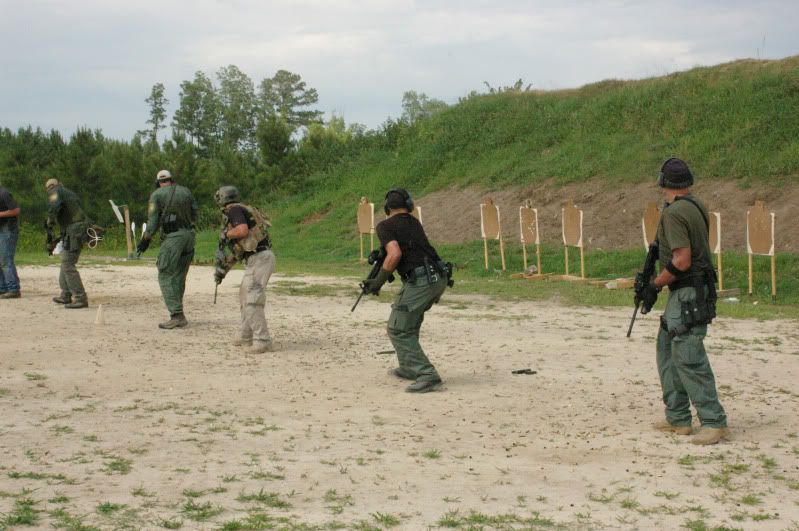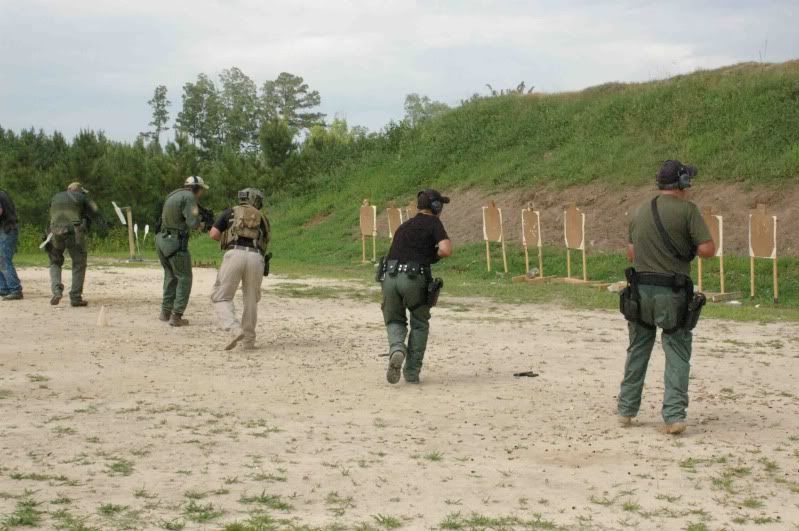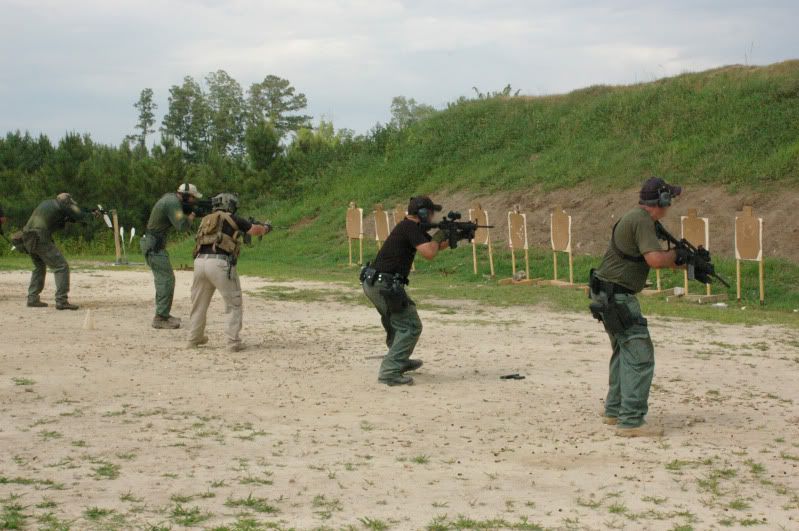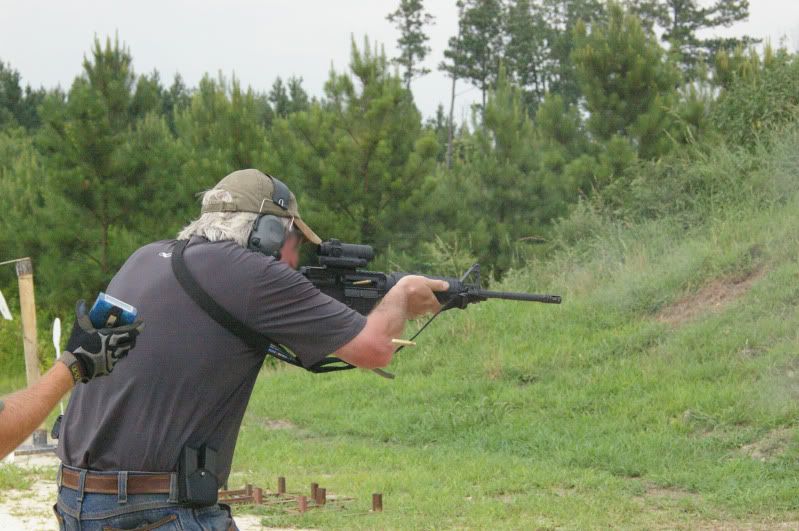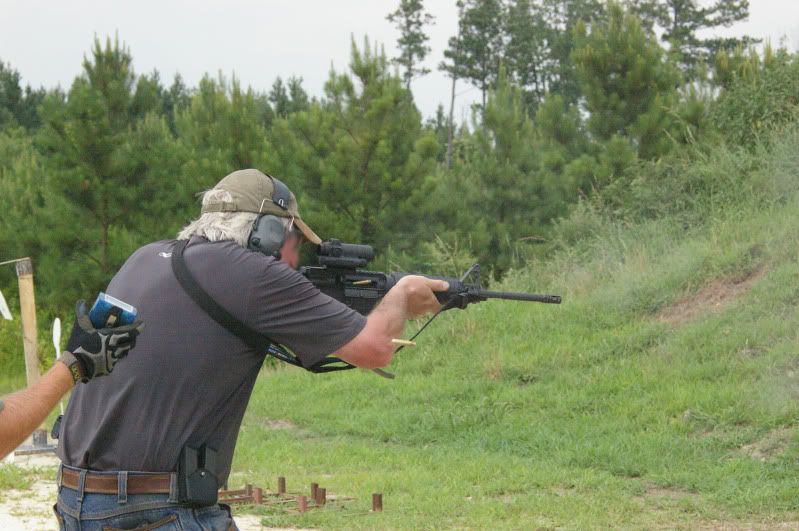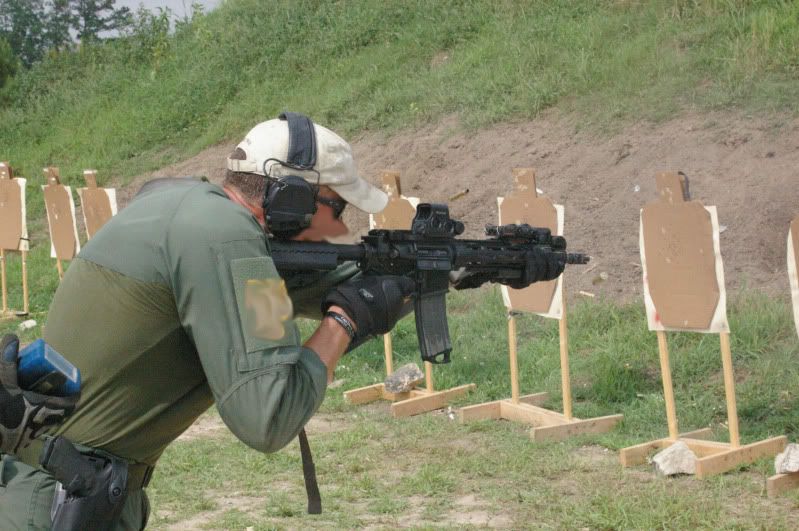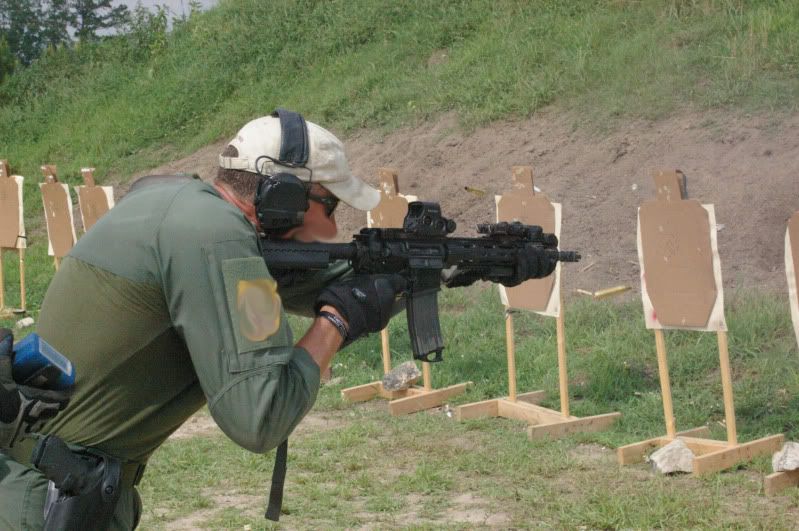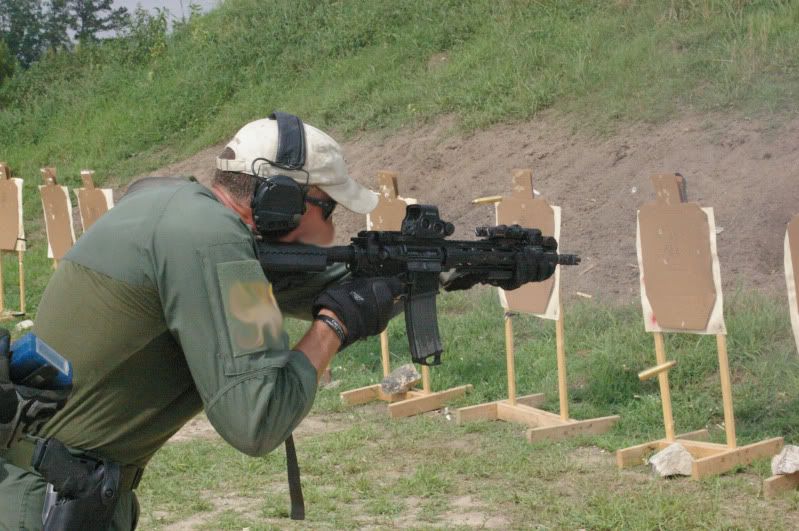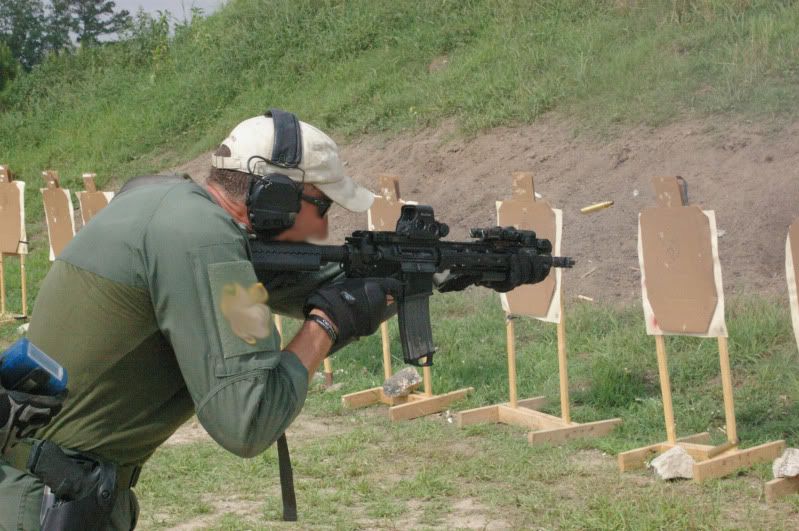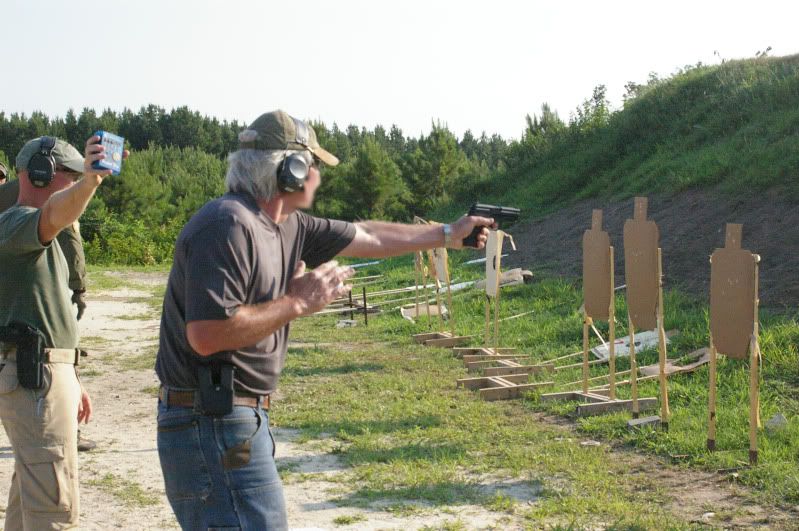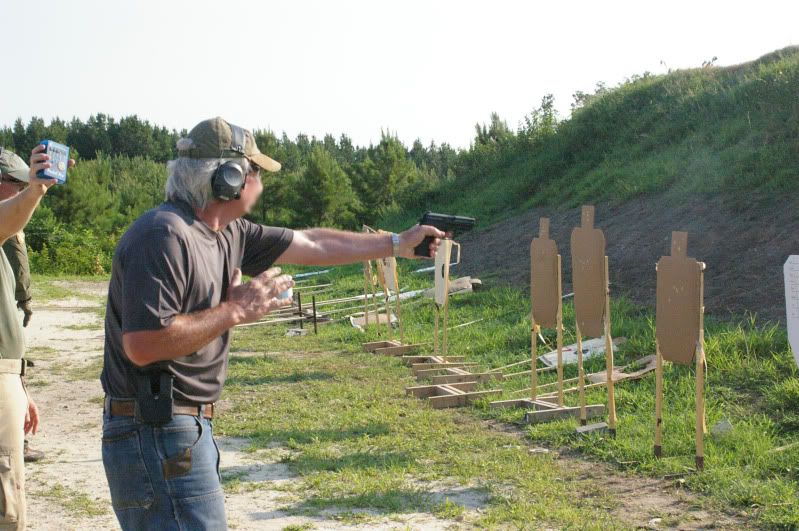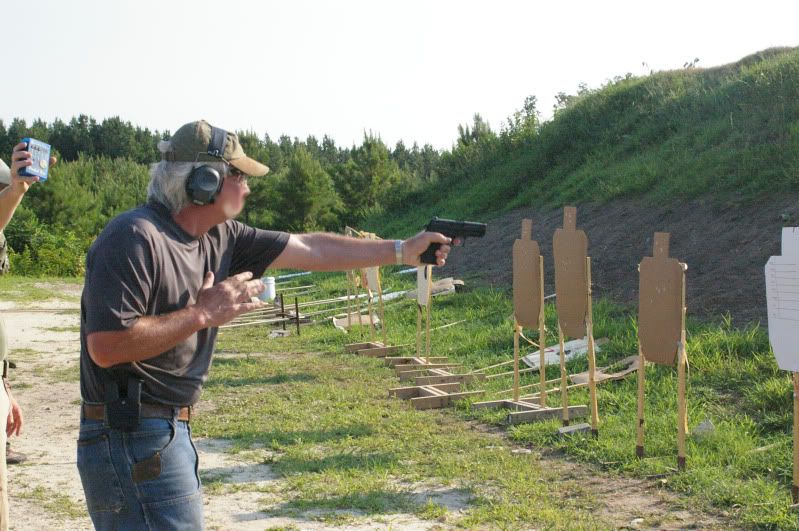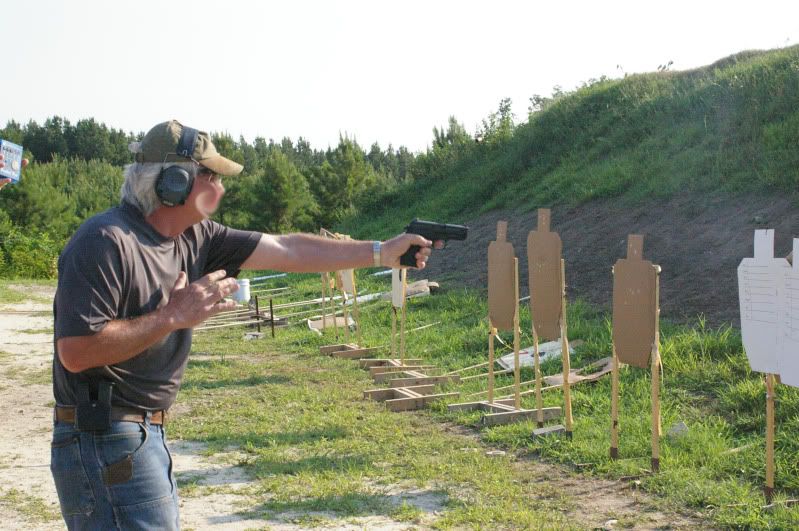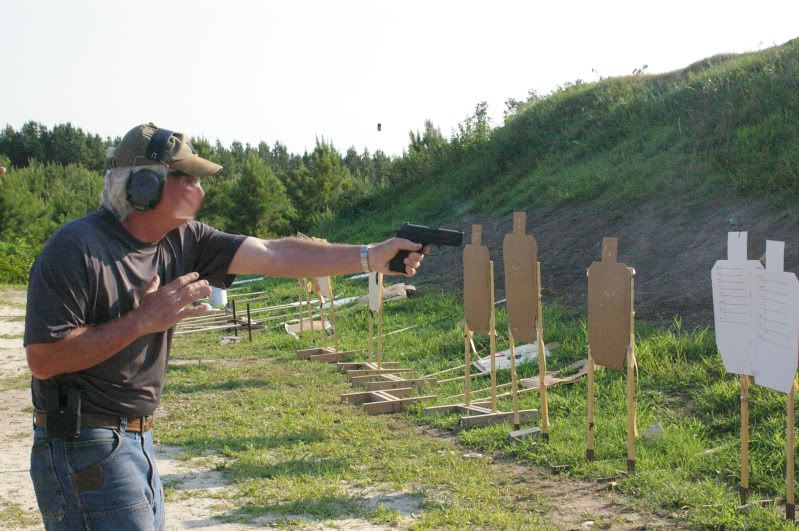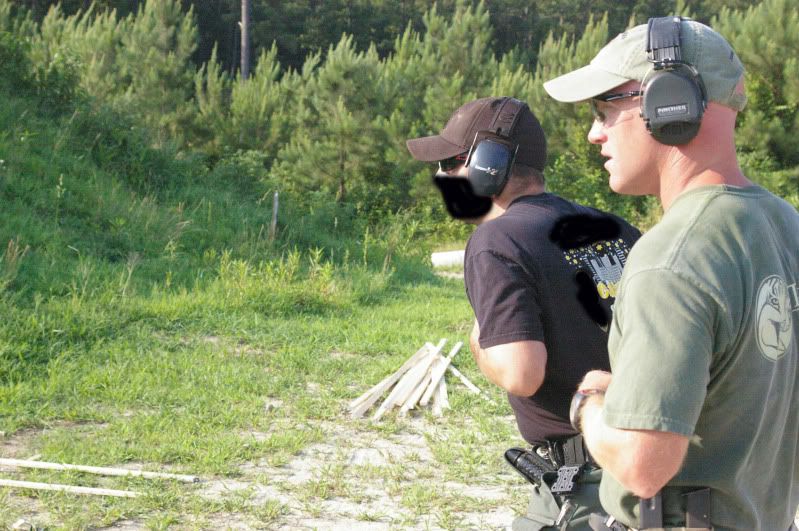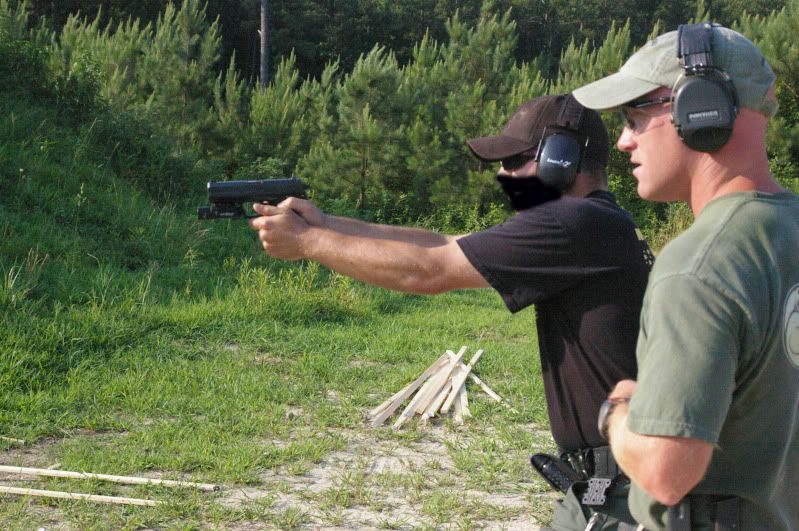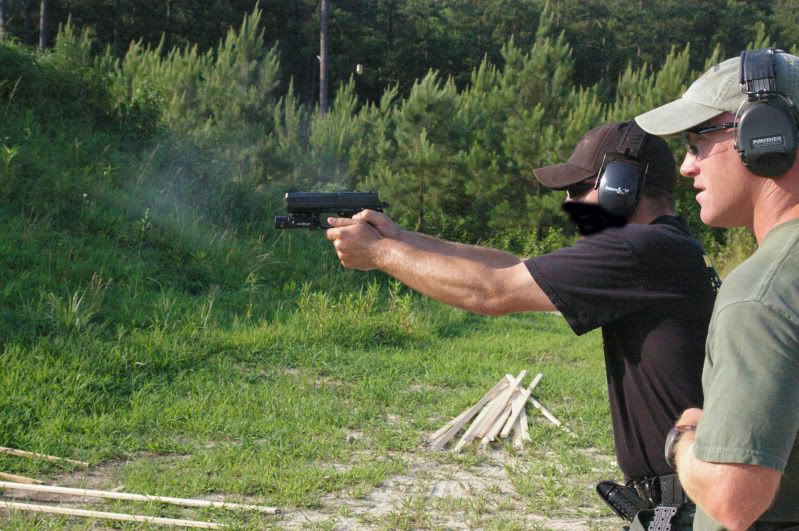-
Murder Machine, Harmless Fuzzball

AAR: TigerSwan 5 day Mil/LE Pistol/Carbine 6/14/2010-6/18/2010
This class was five full days, with pistol instruction done in the morning and carbine instruction in the afternoons. The lead instructor for the course was Kyle Defoor, now the head instructor for Tiger Swan. For those who don’t know Kyle, you can find out more about his background through the Tiger Swan website or through his personal blog. Suffice it to say here that he’s a combat experienced veteran of SOF and an experienced instructor.
Rather than attempt to do a day-by-day breakdown of the course, I will instead focus on the content for the pistol and the carbine seperately.
Pistol:
Kyle lectured on the fundamentals of sight alignment (augmented by later lectures on other aspects of the fundamentals)on a pistol and then we began work at 25 yards on NRA 5.5 inch bullseyes. We fired freestyle, strong hand only, weak hand only, without time constraints, with fairly tight time constraints, kneeling, prone…you name it. This approach to teaching the fundamentals was somewhat unique, in my experience. While the class is intended for those who already have at least a basic level of competence, shooting bullseye at 25 yards with a handgun is still a pretty tall order even for somewhat skilled shooters. According to Kyle, the reasoning behind this approach is simple:
At 25 yards on a 5.5” bullseye, the fundamentals of sight alignment and trigger control must be close to perfect to keep your shots in the black. Even small errors will be plainly evident on paper, offering the student and the instructor(s) sufficient feedback to pinpoint problems with these key fundamentals. At closer ranges it’s possible to get away with poor trigger control or sight alignment with seemingly acceptable results on target. Not so at 25. To paraphrase: “If you can do it at 25, when it comes time to move to 10 it will seem easy.”
Each drill was explained and scored. After every run Kyle looked at each target and offered some generally helpful advice to the student on what he may be doing wrong or how to improve his performance. I’ll note here that it is much easier to do all of this if your sights are actually properly zeroed. My pistol’s sights were not. Shooting bullseye with Kentucky windage sucks, folks…. So before attending a Tiger Swan course I would strongly recommend doing some some shooting at 25 to confirm zero with your sights and the ammo you are going to use.
After a couple of hours of accuracy work on the bullseyes in the morning, we moved to 10 yards and started working on increasing our speed with lectures on presentation/press-out, the draw, the importance of grip in shot-to-shot recovery, etc. The accuracy standards did not degrade much, as we were expected to keep hits in the A zone of an IPSC target, and really just the upper half of the IPSC’s body A zone and the “credit card” A zone in the head. The accuracy standards have a practical basis because the most effective “timers” and the single “switch” in the human body are small and difficult to hit under stress if you don’t hold yourself to high accuracy standards in training.
The pistol instruction covered just about every conceivable area of skill with a pistol from precision accuracy at longer ranges to speed and effectiveness even at arm’s length. It was an eye opening experience for a number of students as some of them found the limitations of their gear. As an example, a police officer in the class discovered that he had a tendancy to accidentally drop the magazine of his weapon (an H&K USP) when he was placed under the relatively mild stress of an audience and a timer. By the second day he was already asking me about advice on another handgun to carry for duty. Between ammo issues, weapon issues, carry gear issues, the sand of the range, and good ol’ fashioned user error there were ample opportunities for learning . Kyle was always quick to offer helpful advice to get students sorted through their issues.
A standard part of the Tiger Swan pistol program is to put students through two demanding shooting tests: The 700 aggregate and the Hackathorn standards. The 700 aggregate is a bullseye standard with all shooting done from 25 yards. After you go through the test once you understand why it is nicknamed “The Humbler”. I won’t cover the details of the course of fire as that’s available elsewhere, but I would encourage you to take a look at it. I gave up a lot of points just on stupidity…like forgetting that my sights were off on the easiest dril in the test…but overall I still managed to scrape out a score of 625. I could have done better, but that’s still not bad for somebody’s first run at the 700 aggregate. There were multiple 600+ student scores in this class, a testament to the skill of the students and the effectiveness of the instruction.
The Hackathorn standard is a much different, and in my opinion more demanding, course of fire that incorporates some pretty demanding speed requirements. Again, I encourage you to look up the course of fire to see what it entails. I turned in a rather dismal performance on the Hackathorn standards, managing a 246. To give an example of how badly I flubbed it, I gave up 15 points on the strong hand only head shots at 5 yards because I neglected to look at those bumpy things on top of the slide that tell you where the bullet is going to go. End result? 3 misses right over the head of each target. I dropped probably an additional 20 points through sheer stupidity by trying to shoot the individual drills faster than the time standard…which is pointless. To give the reader some idea of what “good” is on the stanards, I believe the highest score ever recorded belongs to either Larry Vickers or Rob Leatham with something like a 298 out of a possible 300. Kyle shot the standard right along with us (he also shot the 700 but I don’t remember his score) and scored a 292. That’s an impressive score, folks.
Kyle was clearly very skilled with a handgun, and had a deep enough understanding of how to achieve a high level of performance that he could relate valuable performance ehnancing information to the students. Earlier in the week Kyle noticed that my groups tended to be a bit high and told me that based on watching my stance it may be the result of an extreme eye angle. I have a tendency to drop my head really low to bring it to the gun, which results in looking out the top of my eyes. This extreme eye angle can throw off your groups. After Kyle gave me the heads up I tried…well…keeping my head up. The end result was an immediate change in my groups, which now grouped more or less in the center of the target. I always thought I tended to shoot high because I was misaligning the sights, even though on some of the shots I could have sworn my sight picture was perfect. That’s exactly the kind of “lightbulb moment” input you can only get from an instructor who really knows his stuff.
Some pictures from the course:
At the 25:
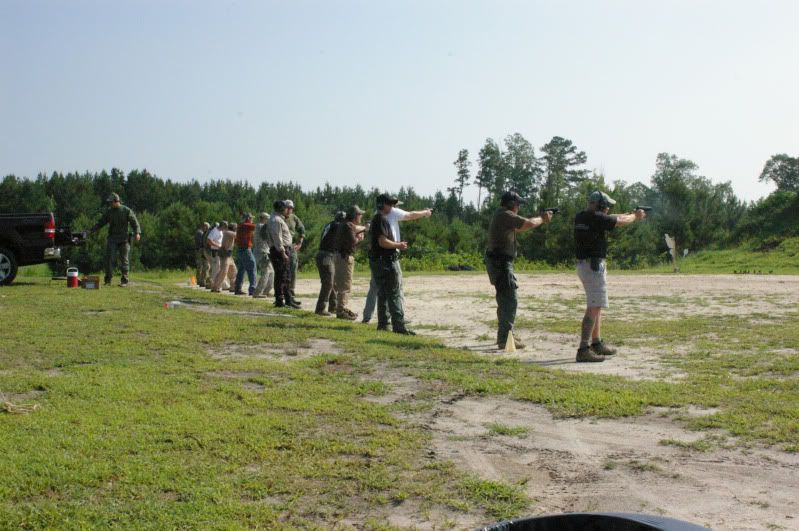
Some ball and dummy:

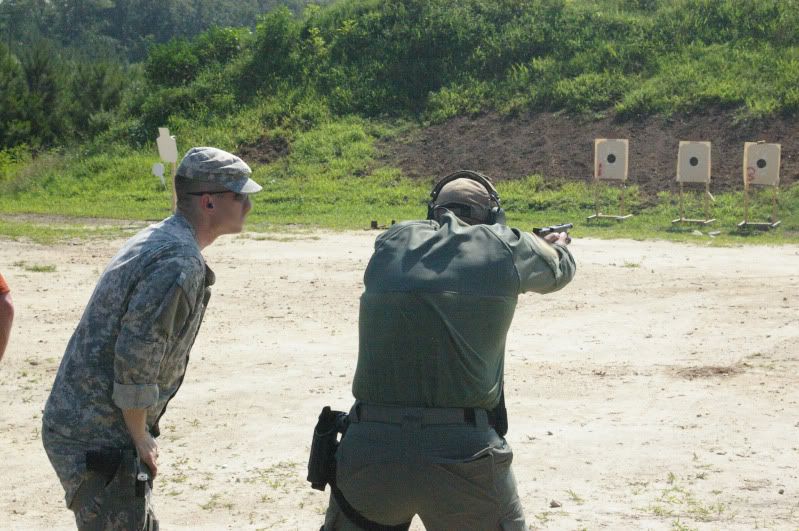
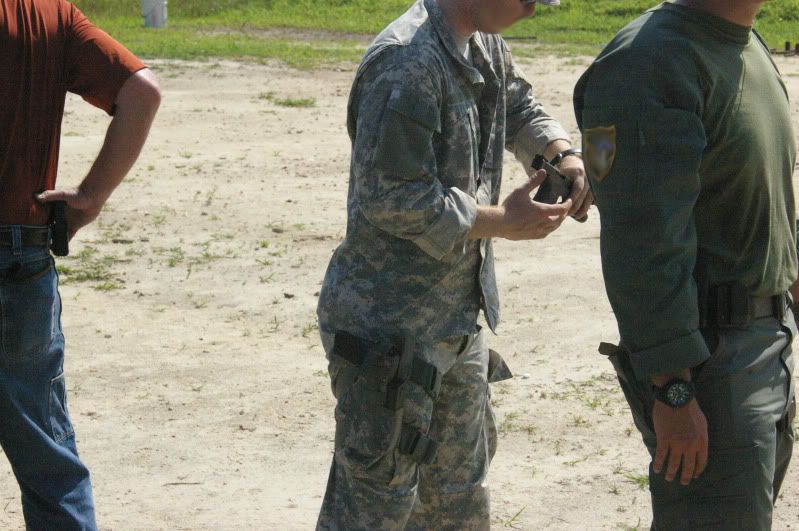

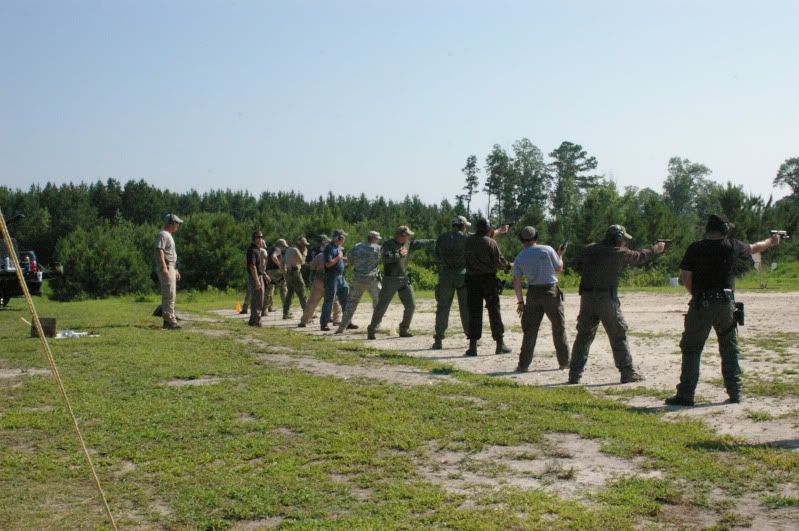
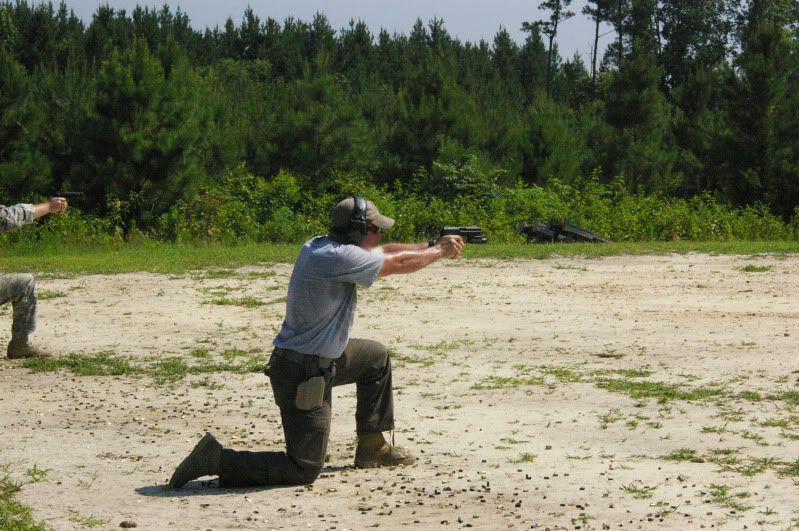
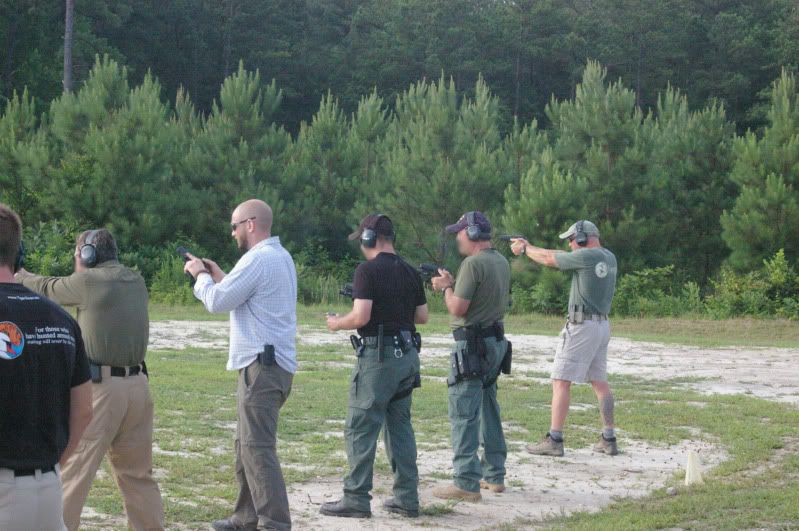
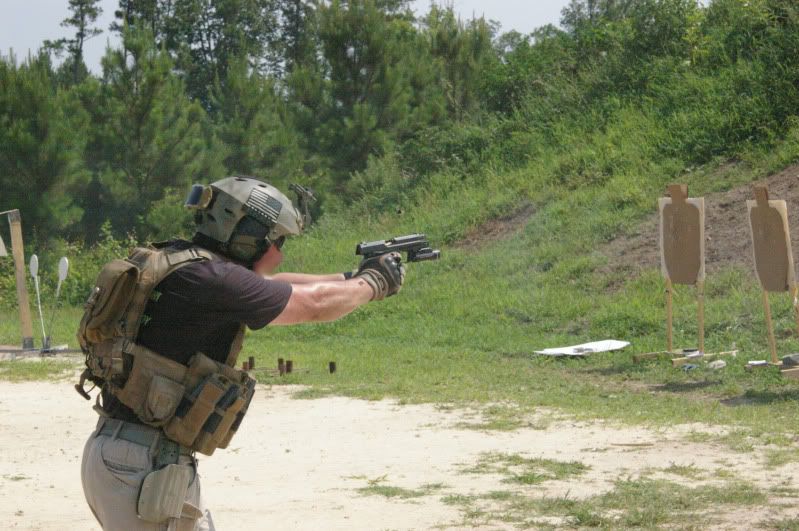

-
Murder Machine, Harmless Fuzzball

-
Murder Machine, Harmless Fuzzball

-
Murder Machine, Harmless Fuzzball

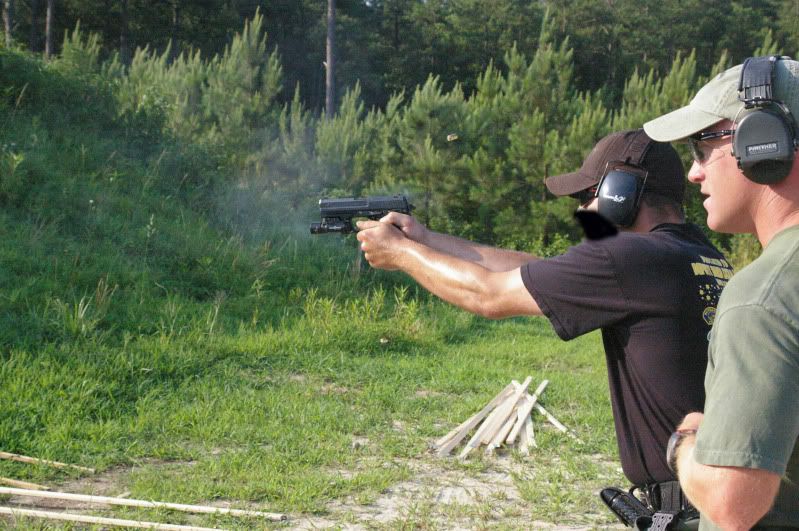
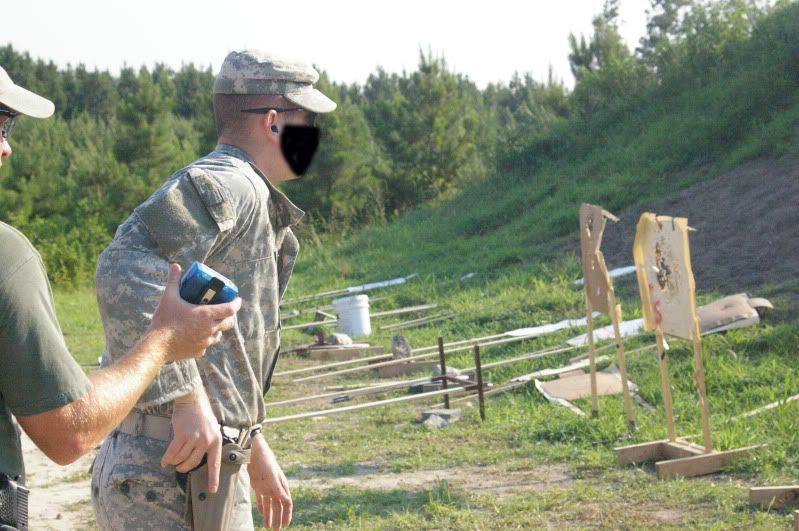


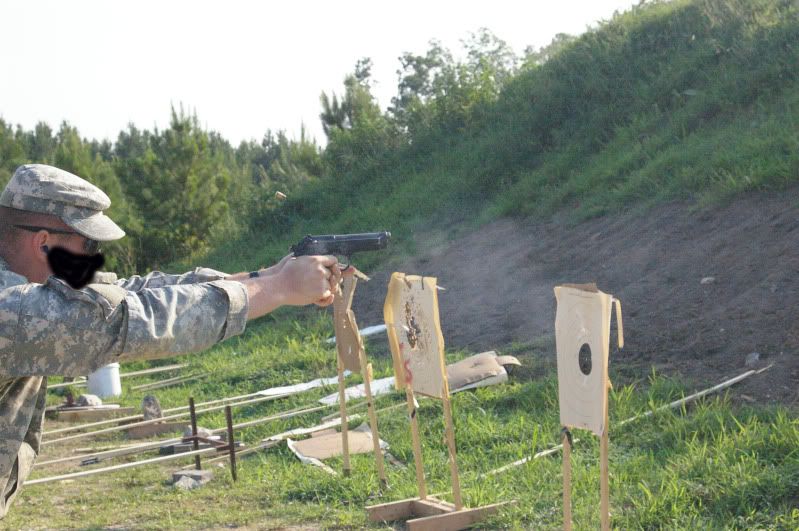
Carbine:
We spent a good bit of our carbine time at 100 or more yards, again shooting at the 5.5" bullseye targets, but we also did close and fast work with the carbine up to three yards. The instruction for carbine also ranged from the fundamental shooting positions to recoil control for maximum speed at closer ranges, covering the broad spectrum of potential application for a carbine. Along the way Kyle gave several lectures about the carbine covering the reasoning behind the 100 yard zero, proper lubrication of the M4, magazines, slings, rails, optics, lasers, white lights, iron sights, stocks, grips, ammunition selection and terminal ballistics, barrel twist, the accuracy potential of shorter barrel lengths...you name it, and Kyle covered it well enough to get you on the right track from then on.
Just as with the pistol, there were a number of carbine related equipment issues in the class. Bad optics, improperly installed optics (example: A canted Aimpoint on an issue carbine for a police officer), bad slings, bad magazines, bad ammo, etc. Yours truly had a particularly bad case of the Mondays when my optic worked loose in the mount not long after I finally managed to get the thing zeroed. (Pro tip: Show up on day 1 with a 100 yard zero on your irons and optics on both your primary gun AND your backup. Life will be much simpler.) As a result, I ended up shooting most of the course with iron sights. I hadn't shot strictly irons in quite some time, but I managed to do reasonably well with them once I finally managed to dial them in. I was reasonably fast and accurate with them. I even managed to turn in the high student score on the 5 yard 1-5 drill with 3.6 seconds (clean, of course) using the iron sights and my new Battle Comp. I even managed to do well when shooting on the move in the most awkward positions.
When it came time to do barricade work, however, I was completely outclassed by the guys with optics when shooting at the 6" steel plates 100 yards away. My zero was good enough to hit the reduced size IPSC steel shilouette from 200 offhand, but 6" steel plates at 100 from awkward positions was just out of my league. The targets were hard to see, my glasses were distorting the sight picture, the heat mirage from my barrel was screwing with my sight picture, and I was rather tired after days in triple digit temperatures with almost 100% humidity. By that point I was just done.
Did I mention that it was hot last week? The thermometer read 108 degrees after lunch on day 2. It was hot. The term "record highs" was being used over and over again by the weather forecasters in the area. There were guys on the line who had been deployed to Iraq and Afghanistan wiping their brow and proclaiming "Jeez, it's hot!" I'm still trying to get the salt stains out of my clothes from all the sweat. I was actually worried we'd have a heat casualty before the week was out, but thankfully nobody dropped on us. Kyle and the AI's kept a careful watch on folks and stuck them in AC with some Gatorade if they started to show signs of heat problems.
-
Murder Machine, Harmless Fuzzball

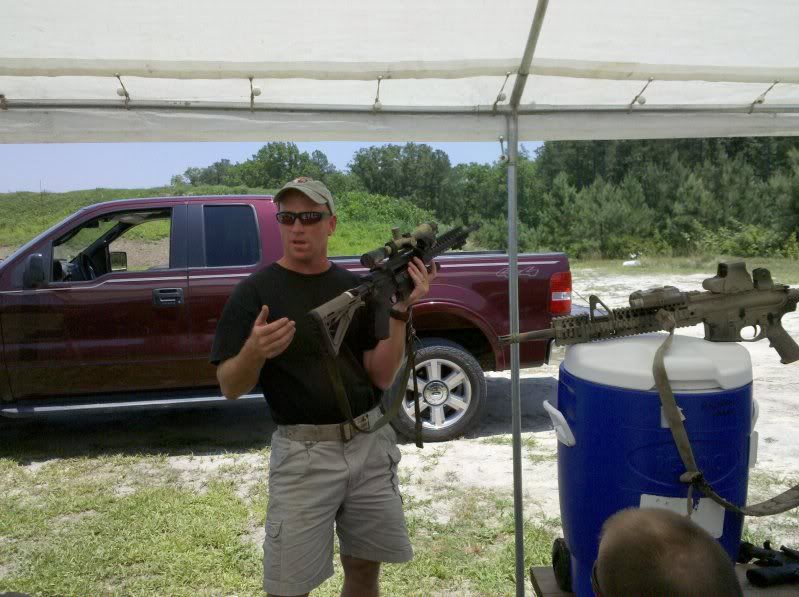
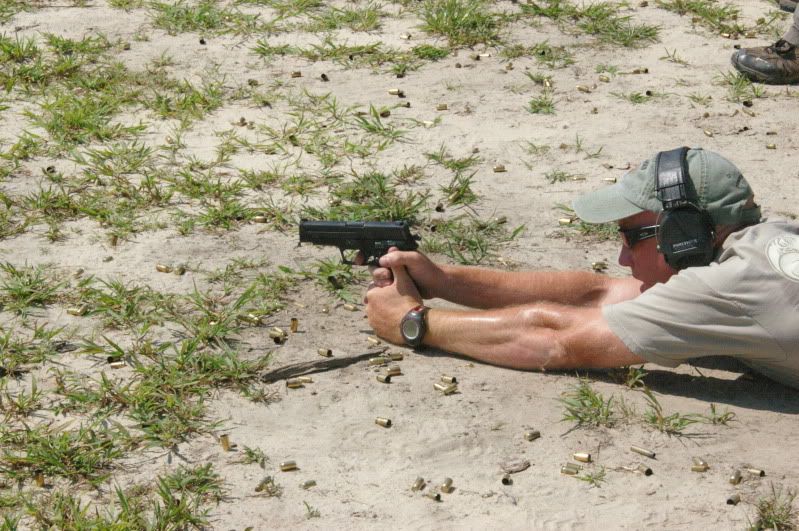
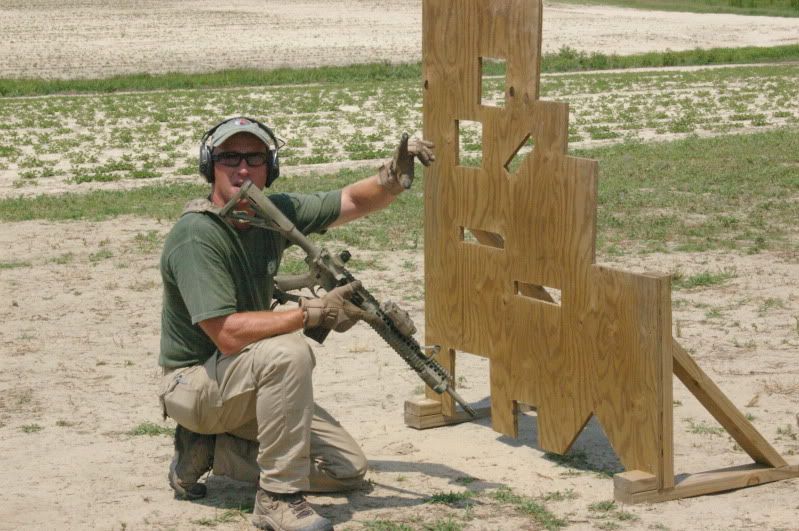
Some final thoughts:
1. There's nothing like a 5 day class to really put your gear...and if it's 108 degrees outside, you as well...through the wringer. There were some profound gear issues in this class that served as wakeup calls. A couple of duty guns that came to the class were to be sidelined immediately after because of the problems encountered over the 5 days of fun in the sun.
2. Lock-tite is your friend. Use it.
3. I've said this before, but when you're in one of these classes you can learn a great deal from your fellow students as well as from the instructors. When you're in a class like this it's likely that you are on the line with a number of people who have expertise in different areas. Take the opportunity to pick their brains. I'm not a gunfighter, but I do know a thing or two about concealed carry and handguns. People approached me with questions in those areas that I was happy to answer, and in return I received a lot of great information from my fellow students. When else will you have the opportunity to learn about taking the rotation of the earth into account when making a 1500 yard sniper shot from a dude with an 800+ yard confirmed kill in Afghanistan?
4. There was a police officer in this class who was shot 7 times with a .45 ACP, including a nasty hit to the face....and he still won the gunfight. A living testament to the primacy of shot placement over caliber.
5. Tiger Swan as an outfit:
The greatest selling point for a Tiger Swan class, in my mind anyway, is the instructor cadre. They have a solid grounding in real world application of what they teach, they're good at teaching it, and they remain open to evolution. Good instructors are always on the lookout for a better way to do things without getting into stuff that's goofy. Kyle and JD and our other AI (whose last name completely crowded out the memory of his first) were approachable, friendly, and always exceptionally helpful, which isn't always easy when you're teaching a class....especially when it's in the triple digits outside. The instructors really are dedicated to ensuring that you get something out of the class.
I want to thank the folks at Tiger Swan and Grey Group for inviting me to check out the course, my fellow students for their tolerance of the camera (I hate camera-men at courses so I can sympathize...but pics help convince people that AAR's are legit for some reason), and lastly the instructors for putting on a great class.
I hadn't seen Kyle since 2006, and it was good to get in class with him again and see how he's evolved as an instructor. His sense of humor certainly wasn't diminished any:
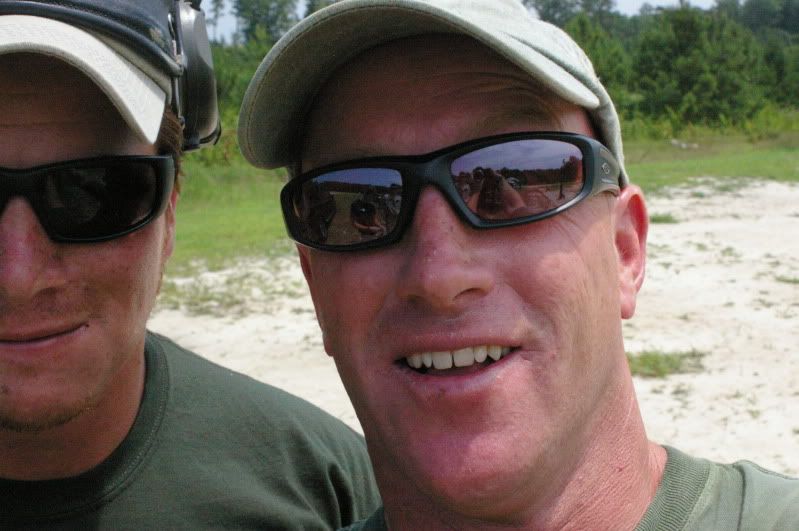
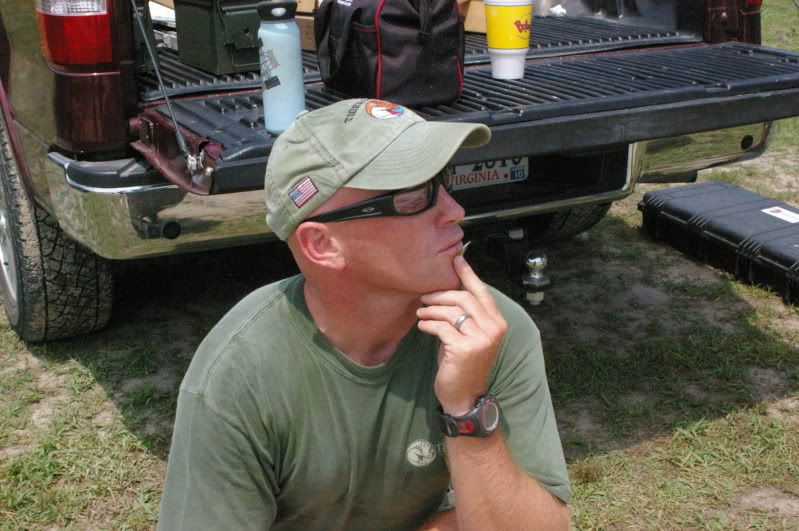
Never leave your camera unattended around a frogman.
 Posting Permissions
Posting Permissions
- You may not post new threads
- You may not post replies
- You may not post attachments
- You may not edit your posts
-
Forum Rules














 Reply With Quote
Reply With Quote